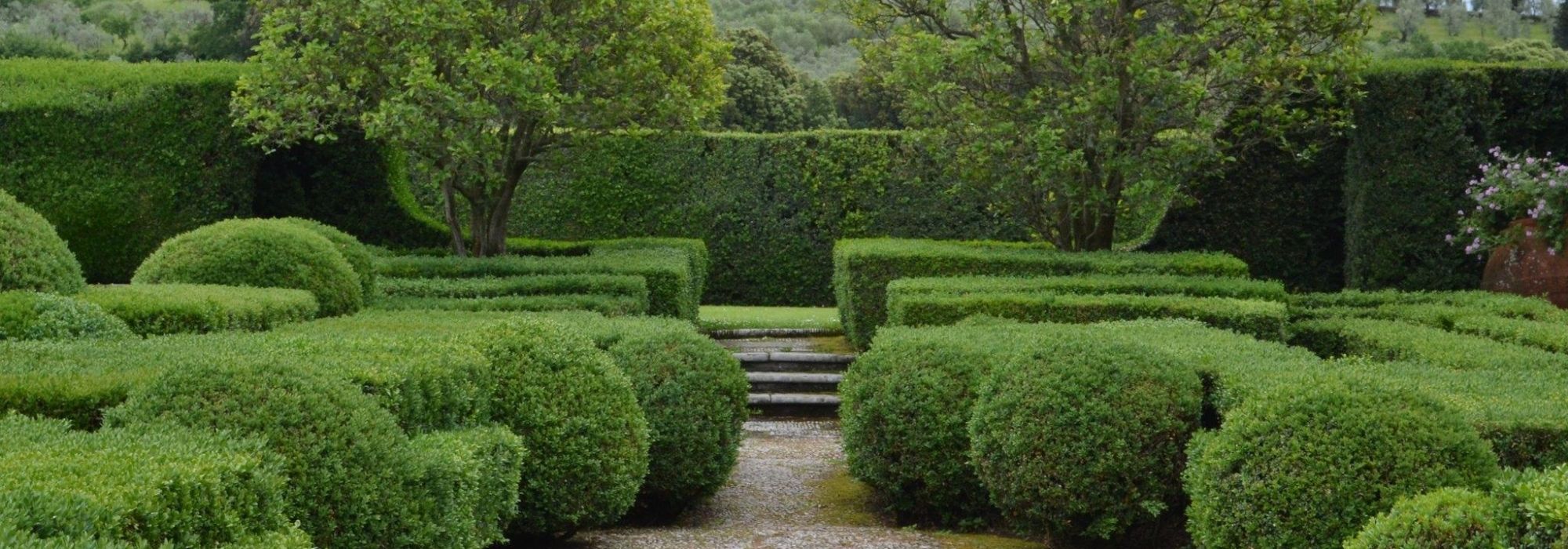
Evergreen tree and shrub: what are they?
Why growing them in the garden?
Contents
In the garden, a distinction is often made between deciduous and evergreen leaves. To simplify, an evergreen tree or evergreen bush or shrub keeps its leaves all year round while deciduous ones lose their leaves in autumn. But in reality, that is not quite accurate.
Evergreen leaves are decorative all year round! Their advantages are many: they are valued for creating evergreen hedges, form perfect privacy screens, and offer a lovely range of leaves (coloured, variegated), flowering and very diverse habits. They prove indispensable in your landscaping because of their permanent structure. Finally, some tolerate repeated pruning very well and are also used for topiary.
Discover everything you need to know about plants with evergreen leaves, their advantages and their usefulness in the garden!
How to recognise them?
All plants need to regenerate their foliage. Evergreen trees and bushes are no exception. Like deciduous plants, they also lose leaves and produce new ones as replacements, gradually, throughout the year, especially in spring. Visually, one therefore gets the impression they keep them!
They are easy to recognise in winter since they remain “always green”. It is also fairly straightforward to identify them in any season by another common feature of this type of plant :
Thick or leathery foliage
Their foliage is often leathery or glossy, even shiny, thicker than that of a deciduous tree or bush. This feature of the foliage helps them resist heat and cold. Indeed, the leaf’s thick cuticle makes it less sensitive to temperature variations.

Thick, leathery, spiny evergreen foliage: Rhododendron and Holly
Mediterranean-type bushes or shrubs also generally have small leaves and are often evergreen (cistus, rosemary, olive trees, ceanothus…). In their case it is about resisting high heat. Reducing leaf surface area actually allows all evergreen plants to reduce evapotranspiration.
Prickly or thorny leaves
Among these leathery foliages, prickly or thorny leaves are often a sign of an evergreen, such as holly, Mahonia, gorse and other junipers.
Small leaves or needles
Many evergreens also have fine or small foliage: conifers, with leaves shaped into very fine points, in the form of needles or scales, are the best-known example of evergreen foliage, and a striking example of trees adapting to harsh climate by reducing leaf size.

Japanese spindle, Choisya ‘Aztec Pearl’, Cryptomeria.
Finally, with autumn and the marked drop in light, photosynthesis can no longer take place for all plants. In many deciduous species, a change of leaf colour in autumn is observed when day length shortens, causing leaves to fall. Evergreens, by contrast, retain their foliage. They shed it gradually throughout their lives but it is much less noticeable, as with conifers where this change occurs over a fairly long cycle. Fallen needles or leaves from pines and bamboos, for example, are nevertheless clear evidence of this.
The case of semi-evergreen foliage
Note that a plant is described as semi-evergreen when it retains part of its leaves through winter. This is often the case when winter is too mild. That said, its foliage will eventually fall and it will renew leaves in spring. These are evergreen plants which, depending on planting region and plant hardiness, will lose more or fewer leaves. This is the case with privet (Ligustrum japonicum), for example.
The case of marcescent foliage
Marcescent foliage is characterised by leaves that persist on the tree, drying out in autumn, giving trees a typical caramel colouring. End of dormancy and the appearance of new shoots in spring will cause the dry leaves to fall. Hornbeam is the best-known example, although some gardeners do not regard it as such; indeed, it tends to become bare quite early in winter. It is not uncommon to see a hornbeam hedge completely bare in December, whereas beech leaves fall during spring awakening. Finally, some oaks (the Holm Oak or Quercus ilex) are marcescent as well.
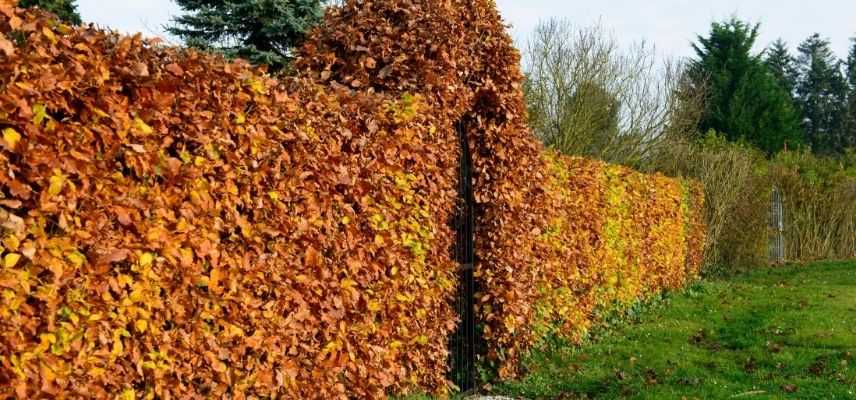
Beech hedge with marcescent foliage
Watch our video: Deciduous, evergreen, marcescent?
Structural plants
The great strength of evergreen foliage is ability to enliven a garden all year round. They structure a space by providing permanent volume within a layout, and deliver an enduring, attractive year-round visual. They act as a true backdrop to the garden and as architectural elements! They also serve to delineate spaces, even to create sub-spaces within the garden.
So it is up to you to choose species planted in your borders, in groups or as isolated specimens. We advise against an ‘all-evergreen’ approach, which can be somewhat monotonous. A key aim in garden design is to mix diversity of foliage: evergreen or deciduous, golden, greyed, green or variegated, foliage of different textures and volumes, etc. It is customary to say 2/3 evergreen foliage and 1/3 deciduous foliage but in practice there is no hard rule.
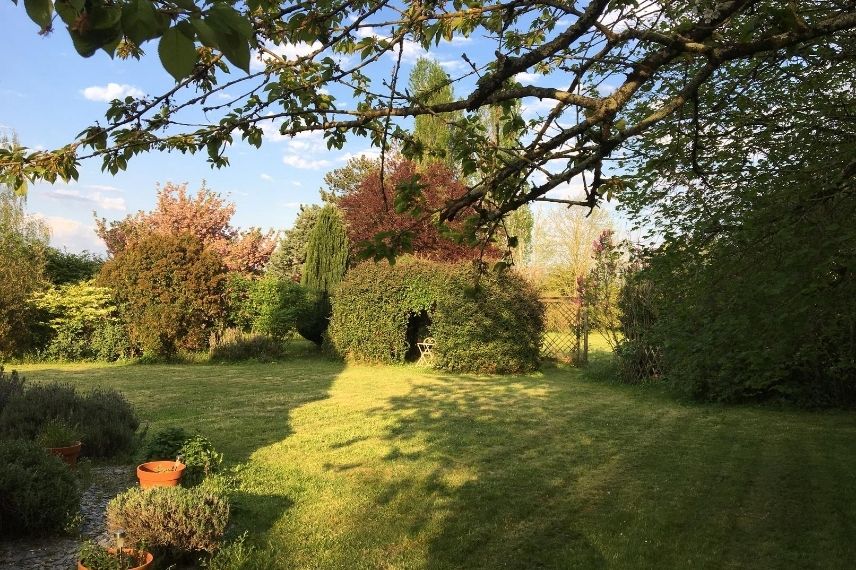
Dissepimental of spaces or dressing and adding volume, evergreens are indispensable for permanent structure of garden (photo Gwenaëlle David Authier)
Discover other Evergreen shrubs
View all →Available in 0 sizes
Available in 1 sizes
Available in 1 sizes
Available in 1 sizes
Available in 1 sizes
Available in 1 sizes
Available in 1 sizes
Available in 1 sizes
Available in 2 sizes
Available in 1 sizes
Perfect privacy screens
Evergreen foliage naturally predisposes them to forming privacy screens that hide from prying eyes: dense separating hedges along a street or road, for example, or to create property-boundary hedges or hedges to divide areas within a large garden or to separate an allotment from the garden. They are chosen for these two uses at different heights; they are also very useful for forming windbreaks, in exposed areas or by the seaside, where they are an effective alternative to a fence.
Discover how to use them as a hedge for all garden styles!

Prunus laurocerasus hedge (cherry laurel)
Read also
Be attentive to evergreen bushesFor defensive hedging
Evergreen foliage becomes effective when chosen for its spiky or thorny nature, deterring intruders from entering beyond boundaries created by the hedge. Shape an impenetrable barrier with hedges made of bushes that are naturally quite tall (about 3m) such as Pyracantha (Firethorn), where you can mix the colour of the berries for a contrasting effect (Pyracantha ‘Soleil d’Or’ with yellow berries and Pyracantha ‘Orange Glow’ with orange berries). A defensive hedge works well when composed of different species, in the manner of a mixed hedge, combining some dense bushes that intermingle with the thorny plants: alternation of certain Ilex (holly), Cotoneasters lacteus, Pyracantha and hawthorn (Crategus laevigata (deciduous), Japanese quince, etc.
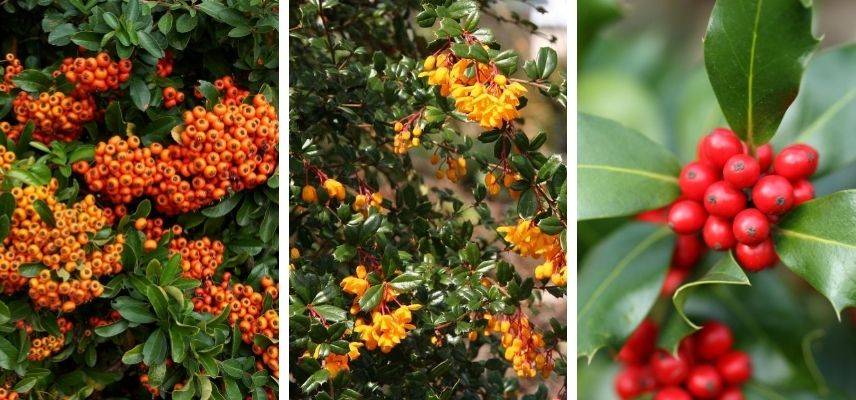
Pyracanthas, Berberis and Ilex are the key bushes to include in your defensive hedge
→ Discover Christine’s advice on creating a defensive hedge
Customisable to suit your tastes
Evergreen foliage is easily shaped! Indeed, it tolerates pruning well and can be given a particular form for fun.
For creating topiaries
Varieties with small leaves such as box (Buxus sempervirens), shrubby honeysuckles (Lonicera nitida), yew (Taxus baccata) or hollies (Ilex), are ideally suited to forming topiary: these are bushes pruned into geometric shapes (cones, spheres…) or into animal shapes, for example. They are perfect for dressing very traditional or decidedly contemporary gardens.
Discover when and how to prune for topiary and 8 bushes perfectly suited.
For creating a Niwaki or cloud-trained tree
Evergreen bushes are also the only ones that can be used to practise the famous cloud pruning or “Niwaki”. This involves clearing the structural branches and keeping small cushions of foliage at the tips to sculpt the tree or bush. Of Japanese origin, this pruning is very fashionable in zen or Japanese-style gardens, but nevertheless requires specific expertise.
Read our advice sheet devoted to the art of cloud pruning.
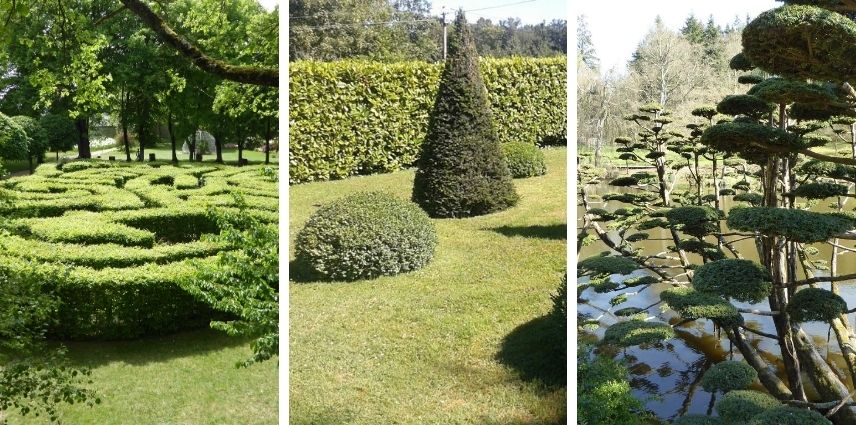
Shaping into mazes, topiary, and cloud pruning.
Wide range of plants
Evergreens present a wide variety of foliage, giving them major landscape value and allowing them to suit many garden styles. They offer :
- A palette of green tones that is particularly interesting: from chartreuse green (a bright yellow-green in many Fusains, Choisyas…), to glossy dark green (Berberis, Ceanothes…), to variegated (Aucubas, Abélias, Pittosporums), purple (Loropetalums, Photinias), bluish (Eucalyptus, Juniperus, Eleagnus…) and silver (Eleagnus).
- Various shapes : large, divided leaves on some “exotics” (Fatsia japonica) or fine foliage (Buxus, Hebes, Pittosporums), elongated (Phormiums and cordylines), with needles or scales for all conifers…
- Various silhouettes (spreading habit, rounded, erect bushy, groundcover, climbing)
- Texture effects (Phlomis and downy Cistus, milky Cotoneasters, Holly and Berberis glossy, Viburnum davidii crinkled, etc)
- Very interesting flowering and fragrance (Choisyas, Abelias, Mahonias, Osmanthuses, Daphnes, Escallonias and many others…)
Note that they are generally low-maintenance and require little pruning.

Abelia, Cupressus, Loropetalum, Chaemerops humilis, Camelia, Pittosporum, Clématite, Ciste
Ecological interest
Finally, beyond these major benefits, evergreen foliage provides shelter and often even cover for wildlife in winter: refuge from the cold for birds, insects and small mammals thanks to leaves and twigs, a source of branches for building nests, shelters and burrows, and food in the form of berries for many bushes. A genuine biodiversity goldmine not to be overlooked in the garden!
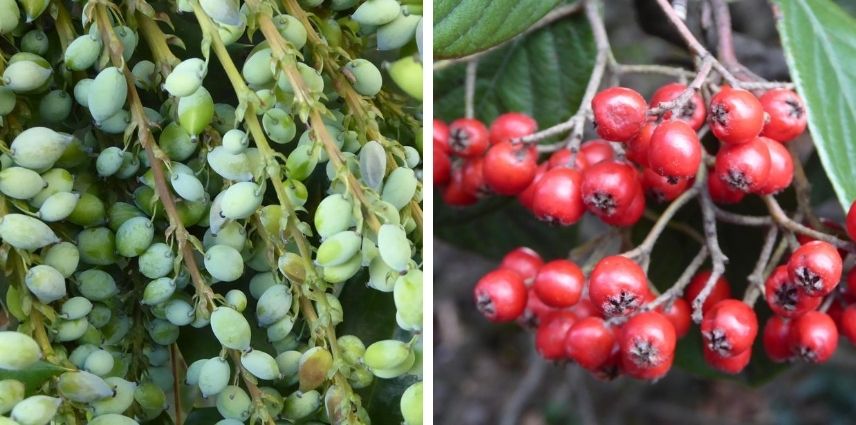
Berries from Mahonia aquifolium and Cotoneasters lacteus delight blackbirds and thrushes in winter
For more information, do not hesitate to read our advice sheet: A natural hedge to enhance biodiversity.
Their drawbacks
As with everything, there are pros and cons. In reality, their disadvantages are few :
- generally slow growth,
- they are often a little more expensive to buy,
- take longer to develop,
- have less spectacular flowering than deciduous foliage,
- and they do not offer a display of foliage colour change in autumn, hence the interest in pairing them with deciduous species !
To learn more
Discover our other tips:
- Using bushes with evergreen foliage in the garden
- 8 evergreen bushes with rapid growth
- 10 evergreen bushes for coastal gardens
- Subscribe!
- Contents
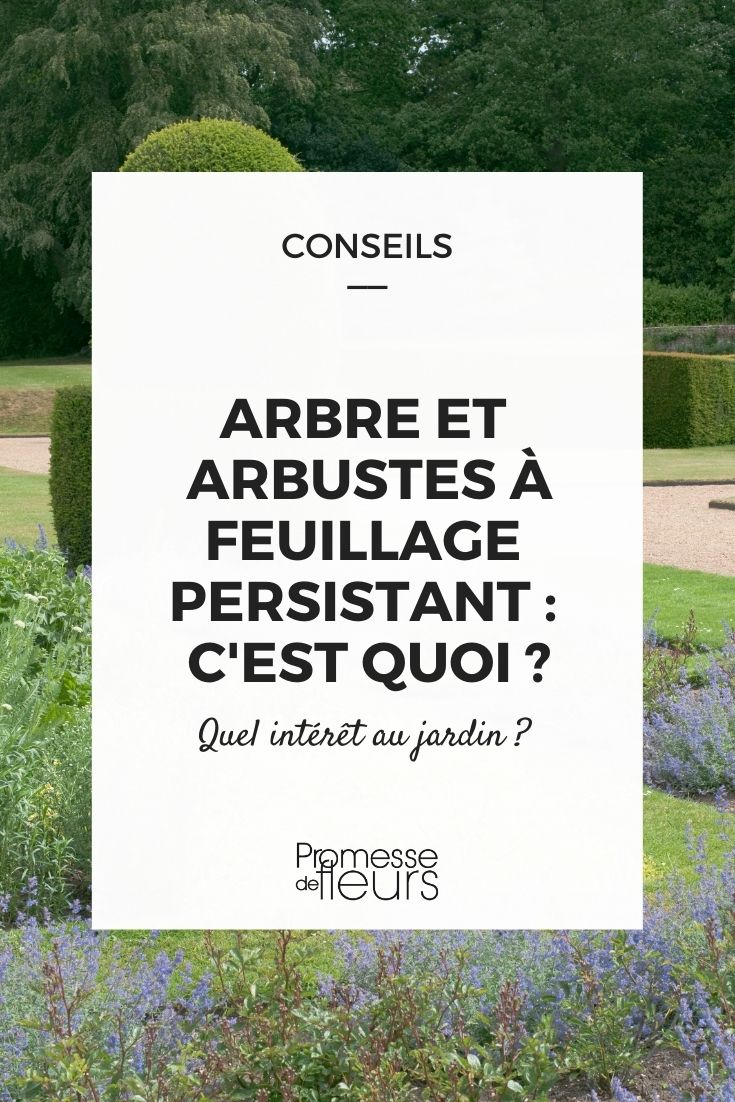


































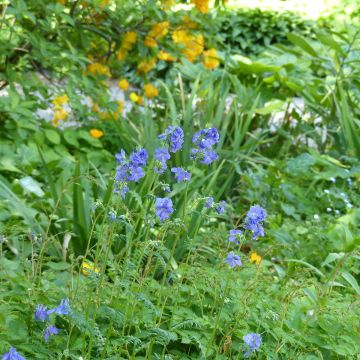
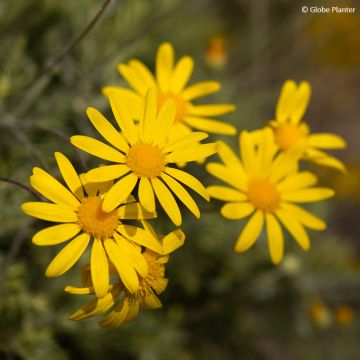
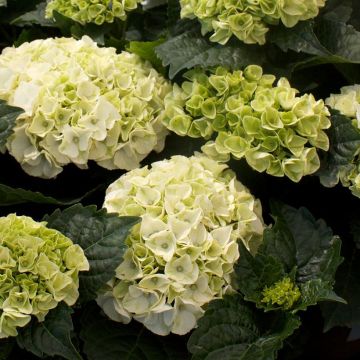
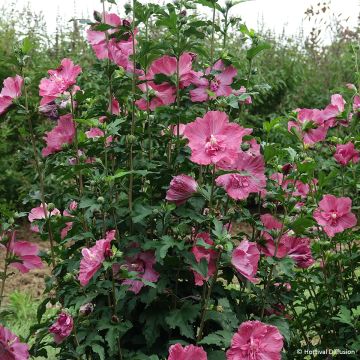



Comments